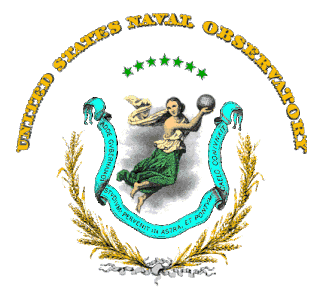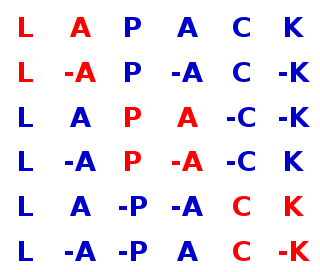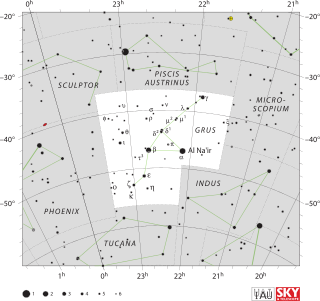
The astronomical unit is a unit of length, roughly the distance from Earth to the Sun. However, that distance varies as Earth orbits the Sun, from a maximum (aphelion) to a minimum (perihelion) and back again once a year. Originally conceived as the average of Earth's aphelion and perihelion, since 2012 it has been defined as exactly 149597870700 metres or about 150 million kilometres. The astronomical unit is used primarily for measuring distances within the Solar System or around other stars. It is also a fundamental component in the definition of another unit of astronomical length, the parsec.
Julian day is the continuous count of days since the beginning of the Julian Period and is used primarily by astronomers, and in software for easily calculating elapsed days between two events.

The United States Naval Observatory (USNO) is one of the oldest scientific agencies in the United States, with a primary mission to produce Positioning, Navigation and Timing (PNT) for the United States Navy and the United States Department of Defense. Located in Northwest Washington, D.C. at the Northwestern end of Embassy Row, it is one of the pre-1900 astronomical observatories located in an urban area; at the time of its construction, it was far from the light pollution thrown off by the (then-smaller) city center. Former USNO director Gernot M. R. Winkler initiated the "Master Clock" service that the USNO still operates, and which provides precise time to the GPS satellite constellation run by the United States Air Force. The USNO performs radio VLBI-based positions of quasars with numerous global collaborators, in order to produce Earth Orientation parameters.
In astronomy and celestial navigation, an ephemeris gives the trajectory of naturally occurring astronomical objects as well as artificial satellites in the sky, i.e., the position over time. The etymology is from Latin ephemeris, meaning 'diary' and from Greek, Modern εφημερίς (ephemeris), meaning 'diary, journal'. Historically, positions were given as printed tables of values, given at regular intervals of date and time. The calculation of these tables was one of the first applications of mechanical computers. Modern ephemerides are often computed electronically, from mathematical models of the motion of astronomical objects and the Earth. However, printed ephemerides are still produced, as they are useful when computational devices are not available.
In astronomy, an epoch is a moment in time used as a reference point for some time-varying astronomical quantity, such as the celestial coordinates or elliptical orbital elements of a celestial body, because these are subject to perturbations and vary with time. These time-varying astronomical quantities might include, for example, the mean longitude or mean anomaly of a body, the node of its orbit relative to a reference plane, the direction of the apogee or aphelion of its orbit, or the size of the major axis of its orbit.

An astronomical object or celestial object is a naturally occurring physical entity, association, or structure that exists in the observable universe. In astronomy, the terms object and body are often used interchangeably. However, an astronomical body or celestial body is a single, tightly bound, contiguous entity, while an astronomical or celestial object is a complex, less cohesively bound structure, which may consist of multiple bodies or even other objects with substructures.

LAPACK is a standard software library for numerical linear algebra. It provides routines for solving systems of linear equations and linear least squares, eigenvalue problems, and singular value decomposition. It also includes routines to implement the associated matrix factorizations such as LU, QR, Cholesky and Schur decomposition. LAPACK was originally written in FORTRAN 77, but moved to Fortran 90 in version 3.2 (2008). The routines handle both real and complex matrices in both single and double precision.

On2 Technologies, formerly known as The Duck Corporation, was a small publicly traded company, founded in New York City in 1992 and headquartered in Clifton Park, New York, that designed video codec technology. It created a series of video codecs called TrueMotion.

Alpha Gruis, Latinized from α Gruis, officially named Alnair, is a single star in the southern constellation of Grus. At magnitude 1.7 it is the brightest star in Grus and one of the brightest stars in the sky. It is a B-type main-sequence star 31 pc away.
An astronomical constant is a physical constant used in astronomy. Formal sets of constants, along with recommended values, have been defined by the International Astronomical Union (IAU) several times: in 1964 and in 1976. In 2009 the IAU adopted a new current set, and recognizing that new observations and techniques continuously provide better values for these constants, they decided to not fix these values, but have the Working Group on Numerical Standards continuously maintain a set of Current Best Estimates. The set of constants is widely reproduced in publications such as the Astronomical Almanac of the United States Naval Observatory and HM Nautical Almanac Office.
Spherical astronomy or positional astronomy is the branch of astronomy that is used to determine the location of objects on the celestial sphere, as seen at a particular date, time, and location on Earth. It relies on the mathematical methods of spherical geometry and the measurements of astrometry.

Beta Columbae, also named Wazn, is the second brightest star in the southern constellation of Columba. It has an apparent visual magnitude of 3.1, which is bright enough to be viewed with the naked eye even from an urban location. Parallax measurements place it at a distance of about 87.2 light-years from the Sun.
Elena Vladimirovna Pitjeva is a Russian astronomer working at the Institute of Applied Astronomy, Russian Academy of Sciences, St. Petersburg. She has published over 100 articles, as listed in Google Scholar and the Astrophysics Data System in the field of solar system dynamics and celestial mechanics . She began employment activity as an engineer-observer at the Astrophysical observation station of the Astronomical Observatory of Leningrad State University in Byurakan (Armenia). Then Pitjeva worked at the Institute of Theoretical Astronomy of the USSA Academy of Science and the Institute Applied Astronomy RAS since the date of its foundation in 1988 as researcher and senior researcher. At present she is head of the Laboratory of Ephemeris Astronomy of this institute. Major research interests of Dr. Pitjeva include the construction of numerical ephemerides of the planets, the determination of the planets' and asteroids' masses, the parameters of planet rotation and planetary topography, the solar corona and oblateness and general relativity testing. She is one of creators of the numerical Ephemerides of Planets and the Moon (EPM) of IAA RAS that originated in the seventies of the past century and have been developed since that time. The version of the EPM2004 ephemeris has been adopted as the ephemeris basis of Russian Astronomical Yearbook since 2006. The updated EPM2008 ephemerides are available to outside users via ftp. The works of Pitjeva have recently been used by several scientists to test several models of modified gravity in the Solar System. Dr. Pitjeva has also contributed to a better understanding an influence of asteroids and Trans-Neptunian Objects on the planets' motion. Recently Dr. Pitjeva collaborated with Dr. Standish and proposed to the IAU Working Group on Numerical Standards for Fundamental Astronomy (NSFA) the values of the masses of the three largest asteroids, the Moon-Earth mass ratio and the astronomical unit in meters, mainly obtained while fitting the constructed DE (JPL) and EPM planet ephemerides. These values have been adopted by the 27 General Assembly of International Astronomical Union as Current Best Estimates as the IAU (2009) System of Astronomical Constants. Pitjeva is a member of the International Astronomical Union: OC of Commission 4 “Ephemerides”, Commission 52 “Relativity in Fundamental Astronomy” IAU WG NSFA.”,
In astronomy, equinox is either of two places on the celestial sphere at which the ecliptic intersects the celestial equator. Although there are two intersections of the ecliptic with the celestial equator, by convention the equinox associated with the sun's ascending node is used as the origin of celestial coordinate systems and referred to simply as the equinox. In contrast to the common usage of spring and fall, or vernal and autumnal, equinoxes, the celestial coordinate system equinox is a direction in space rather than a moment in time.

The Naval Observatory Vector Astrometry Software (NOVAS) is a software library for astrometry-related numerical computations. It is developed by the Astronomical Applications Department, United States Naval Observatory. Currently, NOVAS has three different editions for C, Fortran, and Python, respectively.

Astronomy & Geophysics (A&G) is a scientific journal and trade magazine published on behalf of the Royal Astronomical Society (RAS) by Oxford University Press. It publishes a mixture of content of interest to astronomers and geophysicists: news reports, interviews, topical reviews, historical investigations, obituaries, meeting reports and updates on the activities of the RAS. Full-length articles are peer reviewed.
The barycentric celestial reference system (BCRS) is a coordinate system used in astrometry to specify the location and motions of astronomical objects. It was created in 2000 by the International Astronomical Union (IAU) to be the global standard reference system for objects located outside the gravitational vicinity of Earth: planets, moons, and other Solar System bodies, stars and other objects in the Milky Way galaxy, and extra-galactic objects.
7 Draconis, also named Tianyi, is a single star in the northern circumpolar constellation of Draco. It is visible to the naked eye as a faint orange-hued star with a stellar classification of 5.43. Based upon an annual parallax shift of 4.16 mas as seen from the Earth, the star is located approximately 780 light-years from the Sun.














